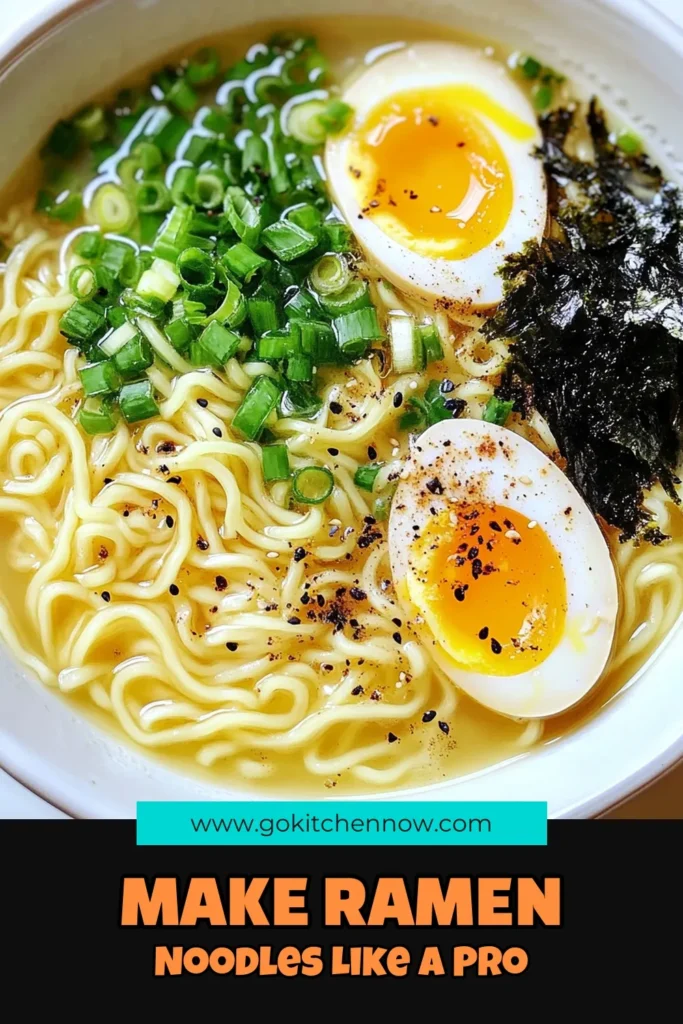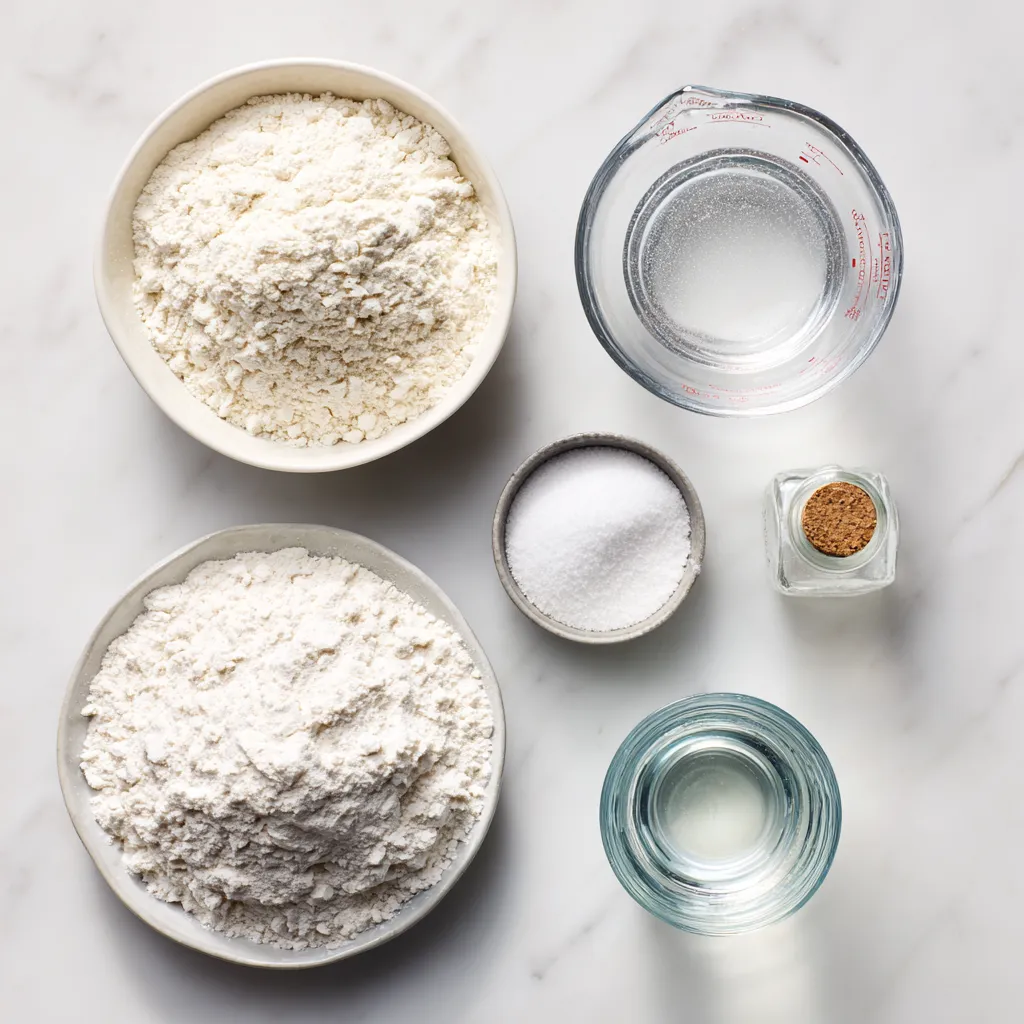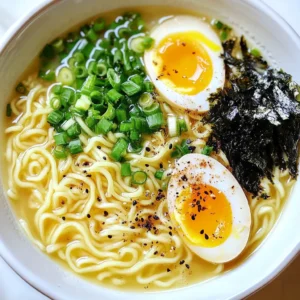WANT TO SAVE THIS RECIPE?
Are you ready to elevate your ramen game? Making homemade ramen noodles is simpler than you think! With just a few key ingredients, you can create a flavorful dish that beats any takeout. This guide walks you through every step, from selecting the right flour to perfecting the texture. Whether you’re a beginner or a pro, you’ll find tips and tricks to ensure perfect noodles every time. Let’s get started!

Why I Love This Recipe
- Fresh and Customizable: Making your own ramen noodles allows you to control the ingredients and tailor them to your taste preferences.
- Fun to Make: The process of kneading and rolling out the dough is a rewarding hands-on experience that can be enjoyed with family or friends.
- Superior Texture: Homemade noodles have a unique chewiness that store-bought versions simply can’t match, enhancing your ramen experience.
- Perfect for Any Occasion: These noodles can be dressed up in a gourmet broth or enjoyed in a simple soup, making them versatile for any meal.
Ingredients
List of Essential Ingredients
To make homemade ramen noodles, you need a few key items. Here’s what to gather:
– 2 cups all-purpose flour
– 1/2 teaspoon salt
– 1/2 teaspoon baking soda
– 3/4 cup water
– 1 teaspoon kansui (alkaline water)
– Cornstarch (for dusting)
These ingredients create a basic dough that transforms into tasty noodles.
Alternative Ingredients for Kansui
If you can’t find kansui, don’t worry. You can use a pinch of baking soda mixed with water instead. This substitution helps mimic the alkaline effect of kansui. It gives your noodles the right texture and color.
Tips for Selecting Flour and Water
When choosing flour, go for all-purpose flour. It works best for ramen. Look for a brand with good protein content. Higher protein helps the noodles stay firm and chewy.
For water, use filtered or bottled water if possible. This ensures a clean taste without any odd flavors from tap water. The quality of your ingredients impacts the final dish, so select wisely!

Step-by-Step Instructions
Detailed Process for Making Ramen Dough
To make the best ramen dough, start with simple ingredients. In a bowl, sift the flour, salt, and baking soda together. This mix helps the noodles rise and gives them a nice texture. In another bowl, mix the water and kansui until it’s well blended. If you can’t find kansui, a pinch of baking soda in water works too. Gradually add this mixture to the flour. Use a fork to stir it until a shaggy dough starts to form.
Next, turn the dough onto a clean surface. Knead it for about 10 to 15 minutes. The dough should feel smooth and elastic. If it sticks, sprinkle a little more flour to help. Once ready, shape the dough into a ball. Wrap it in plastic wrap and let it rest for at least 30 minutes. This resting time is key for the noodles to become tender.
Techniques for Rolling and Cutting Noodles
After the dough has rested, it’s time to roll it out. Divide the dough into 2 to 4 pieces. This makes it easier to handle. On a floured surface, roll each piece until it’s about 1/8 inch thick. Dust the rolled dough lightly with cornstarch. This prevents sticking and helps keep the noodles separate later.
Now, fold the dough into thirds, like an envelope. With a sharp knife, slice the folded dough into thin strips, about 1/4 inch wide. Unravel the noodles and dust them with more cornstarch. This keeps them from clumping together. You’ll see how fun it is to make your own noodles!
Cooking Instructions for the Perfect Noodle Texture
To cook your noodles, bring a pot of water to a rolling boil. Once boiling, gently add the noodles. Cook them for about 2 to 3 minutes. You want them to be tender but still chewy. This is the perfect texture for ramen. Once done, drain the noodles and rinse them with cold water. This stops the cooking process and keeps them firm.
Now, your homemade ramen noodles are ready! Serve them in a rich broth and add toppings like green onions, soft-boiled eggs, or fresh veggies. Enjoy your delicious creation!
Tips & Tricks
Common Mistakes to Avoid When Making Ramen Noodles
Making ramen noodles is fun, but some common mistakes can ruin your batch. Here are the key ones to watch out for:
– Using the wrong flour: Always use all-purpose flour. Other types may not give you the right texture.
– Skipping kansui: This alkaline water gives your noodles the perfect chew. Don’t skip it!
– Not kneading enough: Knead the dough for at least 10 minutes. This builds the gluten, which is important for structure.
How to Ensure Noodle Elasticity and Flavor
Elasticity is key for great ramen. To achieve this:
– Knead well: Your dough needs to be smooth and elastic. If it feels rough, keep kneading!
– Rest your dough: After kneading, let it rest for at least 30 minutes. This helps relax the gluten.
– Use kansui: This ingredient not only adds flavor but also helps with elasticity.
Best Practices for Kneading and Resting the Dough
Kneading and resting are crucial steps in making ramen noodles:
– Knead on a clean surface: This helps you control the dough better. Use a little flour if it’s too sticky.
– Knead until smooth: Don’t rush this part. You want the dough to be soft and pliable.
– Cover the dough: After shaping it into a ball, wrap it in plastic. This keeps it from drying out while resting.
These tips will help you create ramen noodles that are both tasty and fun to eat!
Pro Tips
- Use High-Quality Flour: For the best texture and flavor, choose a high-protein all-purpose flour or even bread flour to give your noodles the perfect chewiness.
- Don’t Skip the Resting Time: Allowing the dough to rest is crucial for gluten development, which makes the noodles easier to roll out and enhances their texture.
- Experiment with Thickness: Adjust the thickness of your noodles based on personal preference. Thicker noodles will have a chewier bite, while thinner noodles will cook faster and have a lighter texture.
- Storing Noodles: If you’re not using the noodles immediately, dust them generously with cornstarch and store them in an airtight container in the refrigerator for up to a week.

Variations
Different Types of Ramen Noodles
Ramen noodles can come in many shapes. You can make curly noodles or straight ones. Curly noodles hold broth well. They give you a fun bite. Straight noodles offer a smooth texture. They are great for lighter soups. You can try both types. It’s fun to see which you like more. Play with the thickness too. Thicker noodles give a heartier feel. Thinner noodles work well in delicate dishes.
Flavoring Your Noodles: Adding Herbs and Spices
You can add flavor to your noodles. Mix in herbs and spices during the dough-making. Try adding garlic powder or onion powder for more taste. Dried herbs like thyme or basil work too. You can even use chili powder for a spicy kick. Just remember to keep the salt level balanced. This will help make every bite tasty.
Vegan and Gluten-Free Ramen Noodle Options
If you need vegan options, it’s easy to adapt. Use all-purpose flour made from chickpeas or rice. This works well for gluten-free noodles. You can still follow the same steps. Just swap regular flour for the gluten-free option. Make sure to check your other ingredients too. Some broths may not be vegan. Always read labels to be sure. Enjoy creating noodles that fit your diet!
Storage Info
How to Store Uncooked Ramen Noodles
Uncooked ramen noodles need the right care to stay fresh. First, dust them lightly with cornstarch. This step keeps them from sticking. Then, place the noodles in an airtight container. You can also wrap them in plastic wrap for more protection. Store the container in the fridge. Uncooked noodles can last up to two days this way.
Tips for Freezing Ramen Noodles
If you want to store noodles for a longer time, freezing is a great option. Start by dusting uncooked noodles with cornstarch. Next, lay them flat on a baking sheet in a single layer. Freeze them for about an hour. Once frozen, transfer the noodles to a freezer bag. Remove as much air as you can before sealing. Frozen noodles can last for about three months. When you’re ready to use them, cook them straight from the freezer.
Best Way to Reheat Cooked Noodles
Reheating cooked noodles is simple. Start by boiling a pot of water. Once it’s boiling, add the cooked noodles for about 1-2 minutes. This method helps them regain their chewy texture. Drain the noodles and rinse them briefly under cold water. You can also reheat them in a pan. Add a splash of broth or oil to keep them moist. This way, they stay tasty and don’t dry out.
FAQs
Can I use regular water instead of kansui?
Yes, you can use regular water. However, kansui adds a special flavor and texture. It helps the noodles get that unique chew. If you can’t find kansui, mix a pinch of baking soda in water. It mimics the effect. Just remember, the flavor won’t be the same.
How long can I store homemade ramen noodles?
You can store homemade ramen noodles for about 3 days in the fridge. Keep them in an airtight container to avoid drying out. If you want to store them longer, freeze the noodles. They can last up to 2 months in the freezer. When ready to use, just boil them straight from the freezer.
What should I serve with my homemade ramen noodles?
Serve your ramen noodles with a rich broth. Top it with sliced green onions, soft-boiled eggs, and nori. You can also add fresh vegetables like bok choy or spinach. Feel free to get creative with your toppings! Each adds great flavor and color to your bowl.
Making ramen noodles is a fun and rewarding process. In this guide, I covered essential ingredients like flour and kansui, and I shared step-by-step instructions for crafting perfect noodles. I also highlighted tips to avoid common mistakes and shared delicious variations.
Now, you can enjoy tasty ramen at home. Remember, practice is key to mastering your technique. Don’t be afraid to experiment with flavors and styles. Your homemade ramen journey starts now. Enjoy every bit
Ultimate Homemade Ramen Noodles
Delicious homemade ramen noodles made from scratch, perfect for your favorite broth.
Prep Time 15 minutes mins
Cook Time 15 minutes mins
Total Time 1 hour hr 30 minutes mins
Course Main Course
Cuisine Japanese
Servings 4
Calories 200 kcal
- 2 cups all-purpose flour
- 0.5 teaspoon salt
- 0.5 teaspoon baking soda
- 0.75 cup water
- 1 teaspoon kansui (alkaline water)
- to taste cornstarch (for dusting)
In a mixing bowl, sift the all-purpose flour, salt, and baking soda together until well combined.
In a separate bowl, mix the water with kansui (or the baking soda if using) until dissolved.
Gradually add the water mixture to the flour blend, stirring with a fork until a shaggy dough begins to form.
Turn the dough out onto a clean surface and knead for about 10-15 minutes until it becomes smooth and elastic. If the dough is too sticky, sprinkle with a little additional flour.
Shape the kneaded dough into a ball, wrap it in plastic wrap, and let it rest for at least 30 minutes at room temperature.
After resting, divide the dough into 2-4 portions to make it easier to roll out. Roll each portion out on a floured surface to a thickness of about 1/8 inch.
Dust the rolled dough lightly with cornstarch to prevent sticking, then fold it into thirds and slice with a sharp knife into thin noodles (around 1/4 inch wide).
Unravel the noodles and dust with more cornstarch to keep them separated.
Bring a pot of water to a boil and lightly cook the noodles for about 2-3 minutes or until they are tender but still chewy. Drain and rinse with cold water to stop the cooking process.
Serve with your favorite toppings like green onions, soft-boiled eggs, and nori.
Keyword homemade, Japanese, noodles, ramen
WANT TO SAVE THIS RECIPE?





